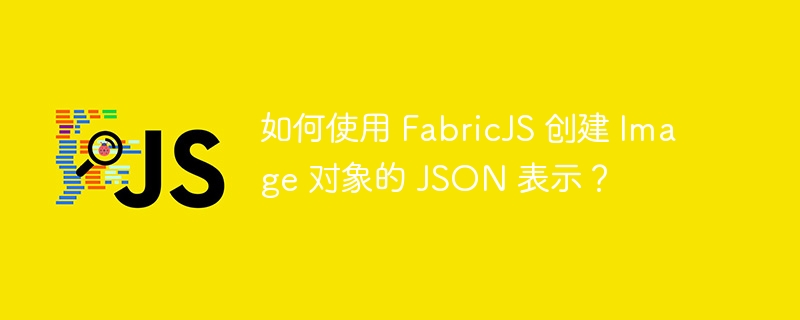

Dans ce tutoriel, nous apprendrons comment créer une représentation JSON d'une image Objets utilisant FabricJS. Nous pouvons créer un objet Image en créant une instance Tissu.Image. Puisqu’il s’agit d’un des éléments de base de FabricJS, on peut aussi facilement Personnalisez-le en appliquant des propriétés telles que l'angle, l'opacité, etc. Pour créer du JSON Pour la représentation des objets Image, nous utilisons la méthode toJSON.
toJSON(propertiesToInclude: Array): Object
propertiesToInclude - Ce paramètre accepte un Array contenant n'importe quel Attributs supplémentaires que nous souhaiterons peut-être inclure dans la sortie. Ce paramètre est Facultatif.
Regardons un exemple de code pour voir la sortie enregistrée lors de l'utilisation de la méthode toJSON. exister Dans ce cas, une représentation JSON de l'instance d'image est renvoyée.
<!DOCTYPE html>
<html>
<head>
<!-- Adding the Fabric JS Library-->
<script src="https://cdnjs.cloudflare.com/ajax/libs/fabric.js/510/fabric.min.js"></script>
</head>
<body>
<h2>Using the toJSON method</h2>
<p>
You can open console from dev tools and see that the logged output contains the JSON representation of the image instance
</p>
<canvas id="canvas"></canvas>
<img src="https://www.tutorialspoint.com/images/logo.png" id="img1" style="display: none" />
<script>
// Initiate a canvas instance
var canvas = new fabric.Canvas("canvas");
canvas.setWidth(document.body.scrollWidth);
canvas.setHeight(250);
// Initiating the image element
var imageElement = document.getElementById("img1");
// Initiate an Image object
var image = new fabric.Image(imageElement, {
top: 50,
left: 110,
});
// Add it to the canvas
canvas.add(image);
// Using the toJSON method
console.log(
"JSON representation of the Image instance is: ",
image.toJSON()
);
</script>
</body>
</html>
Regardons un exemple de code pour voir comment utiliser Méthode toJSON. Dans cet exemple, nous avons ajouté une propriété personnalisée appelée « name ». nous pouvons Transmettez des propriétés spécifiques à l'instance fabric.Image comme deuxième paramètre dans les options object et transmettez la même clé à la méthode toJSON.
<!DOCTYPE html>
<html>
<head>
<!-- Adding the Fabric JS Library-->
<script src="https://cdnjs.cloudflare.com/ajax/libs/fabric.js/510/fabric.min.js"></script>
</head>
<body>
<h2>Using toJSON method to add additional properties</h2>
<p>
You can open console from dev tools and see that the logged output contains added property called name
</p>
<canvas id="canvas"></canvas>
<img src="https://www.tutorialspoint.com/images/logo.png" id="img1" style="display: none" />
<script>
// Initiate a canvas instance
var canvas = new fabric.Canvas("canvas");
canvas.setWidth(document.body.scrollWidth);
canvas.setHeight(250);
// Initiating the image element
var imageElement = document.getElementById("img1");
// Initiate an Image object with name key
// passed in options object
var image = new fabric.Image(imageElement, {
top: 50,
left: 110,
name: "Image instance",
});
// Add it to the canvas
canvas.add(image);
// Using the toJSON method
console.log(
"JSON representation of the Image instance is: ",
image.toJSON(["name"])
);
</script>
</body>
</html>
Dans ce tutoriel, nous utilisons deux exemples pour montrer comment créer du JSON Utilisez FabricJS pour représenter les objets Image.
Ce qui précède est le contenu détaillé de. pour plus d'informations, suivez d'autres articles connexes sur le site Web de PHP en chinois!
 Pourquoi mon téléphone n'est-il pas éteint mais lorsque quelqu'un m'appelle, il me demande de l'éteindre ?
Pourquoi mon téléphone n'est-il pas éteint mais lorsque quelqu'un m'appelle, il me demande de l'éteindre ?
 Port 1433
Port 1433
 description de la page de référencement
description de la page de référencement
 Comment utiliser la balise blockquote
Comment utiliser la balise blockquote
 Comment activer le service de stockage cloud
Comment activer le service de stockage cloud
 Introduction à la signification d'un mot de passe invalide
Introduction à la signification d'un mot de passe invalide
 Méthodes de réparation des vulnérabilités du système informatique
Méthodes de réparation des vulnérabilités du système informatique
 Comment ouvrir un fichier zip
Comment ouvrir un fichier zip